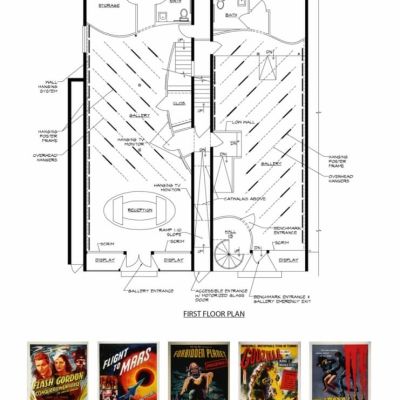ALIEN INVASION
20 MAIN STREET
SOMEWHERE NEAR YOU, VIRGINIA
This project is the story of the relationship between an under-utilized pair of 19th Century mercantile buildings in historic Berryville, Virginia, and an art form primarily devoted to little green men and oversized robots carrying off buxom young women….
This project is a museum to house the clients’ original 1950’s science fiction movie poster collection. These colorful and bizarre posters, which touted the campy, B-grade movies, were reproduced from original paintings. (The paintings were usually done before the movies were actually filmed– consequently, the movie posters were often unrelated to the actual content of the films.) Most of the collector’s posters are “one-sheets,” the term used for the standard 27” x 41” theatrical poster, usually printed on flimsy paper stock and delivered to movie theatres folded.
The museum wanted to have a flexible gallery space, to provide for a comprehensive exhibition of the large collection, specialized exhibits, and an open space for receptions. The museum needed to operate its galleries and its administrative offices as separate entities. It also wanted a screening room for showing these rarely shown movies.
The collection was to be housed in two separate, two-story, wood frame buildings, built in the 1800’s, which required major structural remediation. The renovation had to integrate the two building’s four different floor levels, and an old, four-foot wide, two-story alley, still evident between the two buildings. Because the buildings are in the town’s historic district, the existing facades had to be restored. The only façade intervention was removing the wood siding covering the four-foot wide alley, and inserting a frameless glass, accessible entry door with glazing above, thus articulating the old alley. A new fire exit stair and flying gangplanks span this alley space and connect the second floors of the museum.
Inside the buildings, the posters will be mounted onto new plywood partitions, hung from steel tubes traversing the space and lining the walls. These partitions will allow the posters to be reconfigured, in order to change both the focus of the exhibit and the physical space of the gallery. Flat screen monitors, interspersed through the gallery and reception spaces, will run the movies continuously, providing a changing, kinetic energy to the exhibit of singular media, similar content, and constant dimension. Scrims of various translucencies, printed with images culled from the posters, further help to vary the scale of the exhibit and help to provide disorientation, mystery, and, at the front façade, museum signage and ultraviolet light control.
The fate of the project currently hangs in the balance, trying to reconcile the financial demands of historic renovation / preservation, small town property values, and the desire to create a place to celebrate this campy and bizarre art form.









